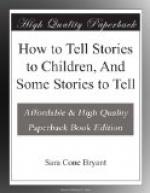[Footnote 1: See Raggylug, page 135.]
It may be a recognition of this factor and its value which has led so many writers of nature stories into the error of over-humanising their four-footed or feathered heroes and heroines. The exaggeration is unnecessary, for there is enough community of lot suggested in the sternest scientific record to constitute a natural basis for sympathy on the part of the human animal. Without any falsity of presentation whatever, the nature story may be counted on as a help in the beginnings of culture of the sympathies. It is not, of course, a help confined to the powers of the nature story; all types of story share in some degree the powers of each. But each has some especial virtue in dominant degree, and the nature story is, on this ground, identified with the thought given.
The nature story shares its influence especially with
THE HISTORICAL STORY
As the one widens the circle of connection with other kinds of life, the other deepens the sense of relation to past lives; it gives the sense of background, of the close and endless connection of generation with generation. A good historical story vitalises the conception of past events and brings their characters into relation with the present. This is especially true of stories of things and persons in the history of our own race. They foster race-consciousness, the feeling of kinship and community of blood. It is this property which makes the historical story so good an agent for furthering a proper national pride in children. Genuine patriotism, neither arrogant nor melodramatic, is so generally recognised as having its roots in early training that I need not dwell on this possibility, further than to note its




